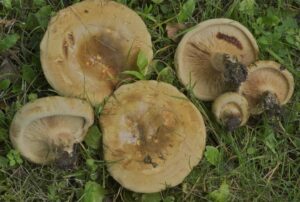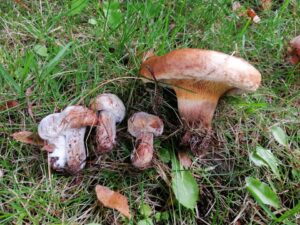Paxillus




What is Paxillus?
The genus represents a gilled member of the order Boletales that is easily distinguishedin the field. The characteristic sporomata are in the shades of brown, caps typically convex to depressed and with a rolled rim (that also gives the group its common name), especially when young, and lamellae decurrent. The caps are mostly 5-15 broad but can extend up to 30 cm in some species. In humans, sporomata of Paxillus can lead to severe gastrointestinal distress and, in some cases, immunohemolytic anemia due to the presence of toxic compounds. Members of the genus form ectomycorrhizae with trees from various taxa, several closely related species being associated with species of Alnus spp. while species from another group act as symbionts of various tree species from genera such as Betula, Quercus, Salix, Tilia, Pinus and Picea.
You can learn more on the genus from the materials below.
Why is this genus interesting for FunDive?
Traditionally, two species were recognised in the genus – P. involutus and P. filamentosus, both of which represent species complexes. Recent studies have introduced several new species from Europe that can be distinguished using DNA barcoding but not always through their morphology. Majority of species occurrence records in public databases have been filed under the two traditional epithets. Collecting and DNA barcoding specimens across Europe would help us to understand the geographic and host range of the at least seven Paxillus species occurring here. While P. involutus is apparently common, there are very few records of P. rubicundulus (=P. filamentosus) s. str. Whether this species and its two siblings each grow with one or different alder species yet needs to be clarified, likewise the status of distinct morphotypes in two other species of the genus.
Therefore, we call to pay attention and collect sporocarps of Paxillus with diverse outlook and habitat origin while trying to avoid piling up collections of P. involutus, rather common with Betula spp. in acidic (damp) woodlands.
The presence of a parasite starting out as a whitish mold, later turning yellowish should also be noted in the remarks or dried as a separate specimen. That will add data for elucidating its distinctness from Hypomyces chrysospermus to which Paxillus parasites have been assigned.
Where can you find species of Paxillus?
P. rubicundulus (=P. filamentosus), P. adelphus and P. olivellus live in symbiosis with alders. These species can thus be found in pure alder stands but also in mixed forests with alders, margins of fields, rivers, ditches etc. Species forming mycorrhizae with trees from other genera include P. ammoniavirescens, P. cuprinus, P. involutus and P. obscurisporus that grow in various types of conifer, deciduous or mixed forests, thickets but also in more open areas like parks, gardens, lawns and grasslands.
Learn more
Keys to the fungi of temperate Europe (Læssøe, T., Petersen, J.H., Frøslev, T.G. & Heilmann-Clausen, J.) – Paxilloids: http://www.mycokey.com/keys/FTE-paxilloids.pdf
